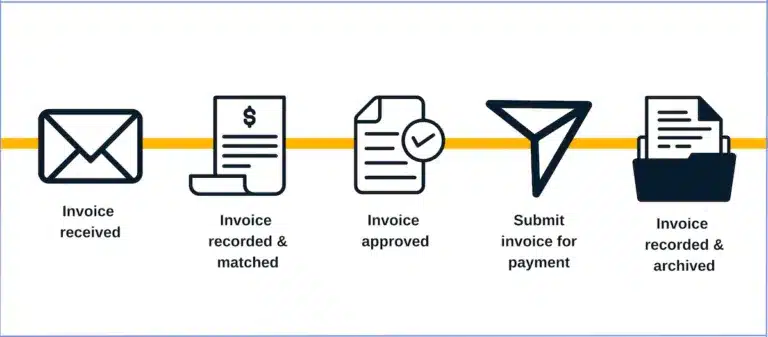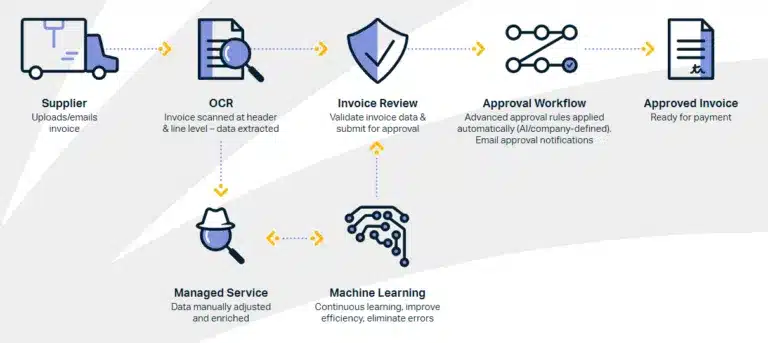
See how forward-thinking finance teams are future-proofing their organizations through AP automation.
Fill out the form to get your free eBook.

Today, the finance function has more responsibilities than ever. In high-growth businesses, every operation—both front and back-office—is inexplicably tied to investment versus reward. To survive the uncharted road ahead, the modern, forward-thinking finance team has to future-proof their organization for success. Download the guide to discover: – The untamed wilderness of finance – How to forge an accounts payable path – How to strategize your next move – The ultimate accounts payable survival tool – How real-life survivalists scaled their businesses
Invoice processing is a key part of the accounts payable cycle. It involves the receiving, approving, and payment of supplier invoices, along with any remittance advice, which is ultimately recorded in the general ledger.
One of the most efficient ways to improve your profitability is to reduce operational costs. This allows you to allocate resources to strategic, revenue-generating initiatives. A significant step towards this is effectively managing open invoices and refining your invoice processing.
When vendor invoices aren’t paid on time, it can disrupt your supply chain and damage business relationships. Suppliers will take measures to protect their own finances. Optimising your invoice processing procedures is therefore essential for business success.
In this article, we’ll explore the fundamental system of invoice processing, what it involves, its benefits, potential problems, and how to improve your entire accounts payable lifecycle.
What is Invoice Processing?
Invoice processing is a core business function that involves the tracking, management, and payment of supplier invoices. It’s typically carried out by the accounts payable department and is a crucial component in the procure-to-pay (P2P) process, representing the final step in procurement.
The process begins when an invoice is received and concludes when the payment is recorded in the general ledger. Nowadays, invoice processing is often done using invoice automation software.
Key Steps in the Invoice Process
What is an invoice? It’s a formal, written request for payment and needs a specific process to handle the document. Once a vendor sends an invoice, there are several steps the accounts payable department must take to process and manage it correctly.
The invoice management cycle is a workflow that includes the following steps:
- The invoice is received
- The invoice is recorded and matched
- The invoice is approved
- The invoice is submitted for payment and processed
- The invoice data is recorded and archived

Traditionally, these steps were carried out manually and could take weeks to complete. AP (accounts payable) automation software significantly shortens this workflow and streamlines the whole system.Traditionally, these steps were carried out manually and could take weeks to complete. AP (accounts payable) automation software significantly shortens this workflow and streamlines the whole system.
Importance of Invoice Processing
It’s incredibly important for a business to optimise the invoice process and organise payments efficiently to ensure that vendors are paid on time. In fact, with early payment discounts, a business stands to earn cash back on money owed. Streamlining the invoice process guarantees the supply chain as a whole remains healthy.
Developing a systemic plan for invoice processing leads to improved:
Cash Flow Management
The proper handling of incoming invoices is essential for successful cash flow management. Optimising the workflow enables a business to stay within budget and keep track of any outstanding debts. This means a business can spend smarter and invest wisely.
Improved Vendor Relationships
The earlier you pay your bills, the happier your vendor will be. Improving invoice performance boosts efficiency and shows your suppliers you value their time. A better system can lead to professional benefits when engaging with vendors, as it’s easier to guarantee the bills are paid when due.
Faster Payment Times
Implementing an invoice processing system makes it simpler to move invoices through the processing structure. This means bills get paid on time and everyone is happy.
Reduced Labour
Developing a more efficient invoice processing system allows a business to reduce the manual workload of its staff. You can then reallocate these resources to more value-added tasks, which will boost morale and productivity.
Additionally, according to the Institute of Financial Management (IOFM), accounts payable is the most time-consuming function in finance, so automating it should be an essential part of any CFO’s strategy to modernise the finance organisation.
Invoice Processing Workflow
As mentioned above, there is a certain workflow the invoice process must follow to ensure your records are accurate and payments go out in a timely fashion. Here, we dive into what each of these steps are:
The Invoice is Received
As soon as accounts payable receives an invoice, the procedure begins. This formal request is also called an invoice to pay.
In the UK, the legal and tax requirements for invoice processing are primarily governed by HM Revenue & Customs (HMRC). For businesses registered for Value Added Tax (VAT), strict rules apply to what constitutes a valid VAT invoice, including key details such as an invoice date, a unique sequential invoice number, the name and address of both the vendor and customer, a clear description of the goods or services sold, and the quantity if applicable, as well as the relevant VAT rate, VAT amounts, and the total amount owed by the customer.
Invoices can be received in a number of ways, including:
- Paper-based documents through the post
- Email with an attachment
- Faxed document
- Electronic documents received through AP software
Regardless of how they are received, you should have a centralised system for processing all invoices in a consistent way. Disparate workflows will not only drive down efficiency, but increase human errors and lead to more confusion.
It’s also important to remember that, under the Making Tax Digital (MTD) for VAT initiative, most VAT-registered businesses (with very limited exemptions) must now keep digital records of all relevant transactions and submit VAT returns using compliant software.
Hence, it’s necessary that you also have a business process to quickly and accurately capture the data from these invoices as they come in. The AP team should be checking off data like:
- The invoice date
- Contact details for both parties
- Description of product/service
- Amount of product/service
- Pricing and total amount owed
The invoice may also contain other payment specifics, like the terms or shipping details. All of this information must then be cross-referenced with other documents to verify the accuracy of the invoice before it can move on to the next step. If any discrepancies arise, the accounts payable (AP) team should immediately contact the vendor.
It should be noted that some vendor send what is known as a pro forma invoice. This is not processed in the same way as a regular invoice and is more of a quote for sales than anything else.
In addition to a pro forma invoice, businesses in the UK vendor encounter various other invoice types: The usual purchase invoices (generated by the vendor for goods or services), sales invoices (generated by the vendor when services or goods are sold to their customers), recurring invoices (sent regularly for repeat service), and credit notes and debit notes (used to correct and adjust previous invoice amounts due to returns, discounts, and under- or overcharges).
The Invoice is Recorded and Matched
The next step in the process involves recording the invoice data and matching it with the right paperwork needed for the approvers to give it the go-ahead. The invoice must be assigned a general ledger (GL) code and linked with the corresponding purchase order (PO), delivery receipt, and/or inspection report where applicable.
The amount billed must match the amount on the original purchase order. If there is a discrepancy in the amount charged (compared to the purchase order) the issue has to be resolved with the vendor prior to entering the approval process or via credit or debit notes. When it comes to a purchase order vs invoice, the PO came first and is therefore more accurate.
Invoices must be formally verified to avoid duplicate payments or fraud. The accounts payable team is looking to record:
Fees, Totals, and VAT
Verification of these details ensures the invoice amounts owed are correctly calculated, including VAT, shipping, and other fees. The total amount of all the calculations is also checked, and the general ledger coding is entered along with the appropriate accounting period.
Verifying the Order
AP will also verify the content of the invoice to determine whether the product being billed for has actually been ordered and received. They will check the number of items, quality, and the agreed-upon price.
Detecting Fraud
Lastly, every invoice undergoes an examination for fraud. The vendor must be validated and pre-approved. Accounts Payable should also check whether the invoice has been sent more than once, and if the line items appear on just that invoice alone, or on multiple invoices.
Additional information to verify includes:
- Vendor information
- Payment terms
- What the invoice is for
- Category codes required for ledger entries
If a business is still processing invoices manually, an orderly file system should be set up that makes it easy to retrieve bills. Always have several copies of the invoice in case there are any vendor discrepancies down the road.
Keep in mind, manual data entry frequently results in typos, errors, and data duplication. The approach is inefficient and costly compared to digital solutions. To realise a higher level of efficiency, companies should optimise the invoice verification component of accounting whenever possible.
The Invoice is Approved
Once all the invoice information is verified, it’s time to get it approved. AP processes for invoice approval will vary by company, industry, invoice type, and policy. Some invoices can be approved automatically, while others may need final approval before submitting payment. Depending on the company’s size, sometimes two or three executives are permitted to approve or deny a payment.
In the past, the invoice approval process was sluggish, resulting in penalties and late payments. Paper-based invoices were sent via internal mail to someone’s physical mailbox. Then came email; where invoices are attached as a digital document and sent to a virtual mailbox. Neither of these approaches is very productive, and both leave a lot of room for documents to get lost, misunderstandings to occur, or people to procrastinate.
The AP invoice approval process works best when automated. It keeps approval workflows in the invoice processing system and creates a definitive timeline for when everything needs to occur. The transparency enables the AP department to see how long an invoice has been in process, if someone has been holding onto the document, and what needs to be done to get it paid.
The Invoice is Submitted for Payment and Processed
Once the invoice is approved, it’s time to pay the vendor. In order to process the payment, an accounts payable representative needs:
- The total owed
- Vendor information
- Payment identifiers (like account number or invoice number)
- Types of payment accepted
The most common method of sending payment used to be via cheque, but now, electronic transfers are preferred, particularly for companies with international business. Popular payment options in the UK include BACS, Faster Payments, and CHAPS.
All of these have different speed and cost implications, while direct debits or open banking API platforms can also be used.
Approved invoices are set for payment based on the terms that are negotiated with the vendor. In some cases, your business may choose to pay an invoice early to take advantage of a discount.
For instance, 1% net 10 means that if you pay that vendor within 10 days of receiving the invoice, you can deduct 1% off the total amount owed. An AP automation solution can streamline this entire process and create more opportunities for a business to take advantage of early payment discounts.
The Invoice Data is Recorded and Archived
Once the payment is processed, all of the final data can be captured and archived. At this point, general ledger entries for the payment debits and any other relevant accounting can be made.
Additionally, invoice images and supporting documents, like purchase orders or shipping receipts, can be saved in a secure and searchable document repository. This ensures a convenient audit trail that’s easily accessed whenever needed.
Accurate data on accounts payables is critical to producing a balance sheet that is correct. An automation system allows a business to make important GL entries into SAP or other systems with a few clicks, instead of the manual entries that are highly susceptible to errors.
Invoice Processing Workflow with Tipalti
Tipalti enables businesses to take advantage of its best-in-class automated invoice workflow. By combining our Supplier Hub, Optical Character Recognition (OCR) Technology, Machine Learning, Managed Services, and Advanced Approval workflow, your team is freed from dealing with one of the most mundane data-entry tasks in the business world. Learn more about Tipalti’s invoice management and bill processing system for AP.

Who Uses Invoice Processing?
Invoice processing is performed by the accounts payable department and is used by
any business that needs to pay suppliers. Without the ability to process invoices, people will stop selling you things on credit. This will lead to slower cash flow, diminished working capital, and strained vendor relationships.
It’s not enough to pay people. They must be paid on time, and consistently. There is a specific series of steps a business follows for managing supplier invoices, from receipt to payment and recordkeeping.
Challenges Faced in Invoice Processing
The more vendors a business deals with, the more complex the invoice process. As your business grows, the need for an efficient system becomes apparent. Without it, here are some common challenges you may face:
Missing Documents
The number one weak link in invoice processing is losing important documents you need to pay the vendor. This typically becomes an issue when a business is growing rapidly and has several different suppliers to pay, in a variety of ways. There must be a means of consolidating all of the paper-based copies, PDFs, word files, etc. Otherwise, the workflow becomes…almost unworkable.
Inaccurate Data
An invoice contains important payment data that is needed for processing, like VAT numbers, prices, delivery times, and so on. When invoices are received in different formats, it makes it that much harder to extract all the essential data.
When it comes to invoice processing, common blunders include:
- Using the wrong client name
- Data errors in VAT numbers or company address
- Failure to clearly itemise products/services
- No invoice details for the deadline
- Failure to use the correct currency
- Bad math or incorrect calculations
Vendors may also fail to specify a discount or extra fees that apply. Any missing or inaccurate data means the invoice needs to go back to the vendor for editing, and the entire process starts over.
Invoice Status Unknown
The present status of an invoice in the processing flow is frequently unknown, particularly when there are several stakeholders involved in the process. Where is it located? Who is going to approve it? When are the funds being sent out? These are all questions that emerge when there isn’t transparency in the workflow.
Routing Errors
Every day, you may be getting invoices from different vendors. After an initial review, each invoice is placed in the routing queue. However, even the most efficient AP team can make an error in the routing process.
In this case, an invoice may languish on the wrong desk or unopened in someone’s mailbox. When an invoice is incorrectly routed, it undergoes repetitive procedures, wasting time and effort. This high-touch circumstance can be incredibly demanding, especially since the AP team needs to close books on a monthly basis.
Using Automated Invoice Processing
Processing invoices manually is not only time-consuming, but it can be prone to errors. While precise figures for the UK vary, industry research suggests that a significant proportion of businesses still rely on some level of manual processes, despite the well-known benefits of automation.
Surveys often indicate that close to 50% of companies use some level of manual processes and paper-based invoice processing, while those that have automated invoice processing solutions will see a decrease of the processing costs, while benefiting from improved accuracy and speed of invoice payment.
Invoice processing automation uses software to mechanise steps in the invoice lifecycle, like data capture and the approval process.
This can either be run by a human user or completely automated through AI systems. This type of solution will automatically extract invoice data (through features like OCR processing) and digitise sending out supplier payments.
Popular accounting systems such as Xero, Sage, and QuickBooks often include integrated invoice management tools.
Automation seamlessly inputs data into your ERP or accounts payable system like SAP or Oracle NetSuite, enabling payments to be made in minutes, rather than days. It allows AP teams to take a “hands-off” approach, freeing them up to focus on more growth-based tasks.
Some key features of invoice processing software include:
- Standardised coding
- Invoice scanning and data capture
- Automated approval workflows
- Collaborative dashboards for transparency
- Integrations with ERP platforms and other apps
The dashboard will show a business who has been paid, real-time invoice status, what is set to go out, and which invoices are awaiting approval. Direct integrations with ERP systems help to increase the accuracy and timeliness of payments, as well as simplify the entire accounts payable process. This works to improve cash management and expedite financial close.
Benefits of Automated Invoice Processing
Effective invoice processing ensures all of your vendor payment information is accessible in a convenient repository and that everyone you’re doing business with, is getting paid on time. The following are a few key benefits of streamlining our invoice process:
Real-time Information
When invoice processing is automated, every invoice is entered with a timestamp. No changes can be made once it has been authorised, which standardises the accounting process. It also provides a wealth of information in real-time on how your business is performing, in terms of sales and cash flow.
Digital Data Storage
Automated invoice processing ensures valuable sales invoices are kept digitally and can be used to quickly consolidate receivables. It enables a team to monitor cash flow from anywhere, at any time.
Additionally, when you digitise bills, you no longer need a large physical space to keep files. This provides superior security as well, since a business can encrypt data and preserve backups virtually.
Centralised Dashboard
Invoice data can be kept in a central location, giving AP the ability to access consolidated accounting information across space and time. Invoicing payment software can also help to reduce duplicate invoices and payments.
Efficient Reporting
Automating the AP process ensures vital information is systemically recorded in a centralised database. This can be used for different comparisons, reporting tasks, trending, and even sales forecasting.
Management also has access to real-world data with tracking functionality, including taxation and legal requirements. It adds more control over internal processing and cuts down on error rates.
Save Time and Money
Invoice process software speeds up the approval process and reduces processing time. It also helps to save on labour costs, as staff have more opportunities to focus on business-critical tasks.
It also allows a business to better position itself for early payment discounts and avoid late payment fees. It completely slashes the cost of manually processing invoices (like postage and paper).
The Quest to Keep Improving
The less money a business can spend on non-revenue-generating tasks, the better opportunity it has for growth. Accounts payable has never been a profit centre, so you must examine other ways to deliver value. Every aspect of the company needs to carefully consider its technology suite, not just sales and marketing. Finance is a team that greatly benefits from automation; adding more control over internal processes and expediting workflows.
To an AP team, efficiency means the ability to cut down on the invoice backlog, create real-time visibility for cash flow, reduce errors, and eliminate repetitive tasks. The faster they can accomplish these goals, the easier it will be to build the business.
Leadership can still maintain current processes, while entertaining smarter functionality like optical character recognition, automated approval routing, and instant reconciliation. The key to adding value is to reduce operating expenses, increase efficiency, and save time. Automation serves as the answer to all of these challenges, and then some.
Moving Toward Automated Invoice Processing
Tipalti’s automated invoice processing includes high-quality OCR data capture combined with continuous machine learning and managed services, including advanced approval routing workflow, all integrated with Tipalti’s unified global supplier payments solution, so that the end-to-end core AP processes are managed seamlessly in one place.
Tipalti’s AP capabilities include global supplier management, self-service supplier onboarding, payments data validation, sanctions screening, KPMG-approved tax compliance, invoice processing (adhering to legal requirements and regulations within the UK, including keeping accurate digital records and compliant VAT handling practices), PO matching, global supplier remittance, early payments, foreign exchange conversion, AP reporting, and invoice payment reconciliation with various ERP systems.
Ready to start your own automation journey? Schedule a demo with us today.
Note: Businesses in the UK must be aware of challenges such as late payments and data protection rules (GDPR). Invoice finance and credit insurance are strategies used to mitigate risks. For the most accurate and up-to-date information, always check directly with your local tax authorities, including the official HMRC website.
